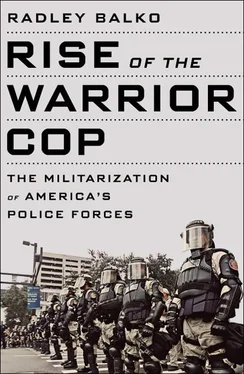IN THE YEARS THAT FOLLOWED ROME’S FALL, ORGANIZED policing largely disappeared from Europe. One exception were the few cities in Italy that became hubs of trade and culture. As they grew, cities like Florence and Venice had to contend with urban issues of crime, poverty, and disease. To keep order—which kept the trade flowing—leaders established patrols to protect the property of businesses, tradesmen, and manufacturers and to enforce curfews during outbreaks.
By the Middle Ages, a nationalized police force had emerged in France, though more as an effort to protect the monarchy from revolt than to protect the citizens from crime. Maintaining the existing order was the only priority; civil liberties were of little concern.
The English tradition was different. Because of its isolation, England was relatively more stable than continental Europe during the Dark and Middle Ages. It didn’t face the constant threat of revolution. Ruling regimes in other parts of Europe had to maintain order by suppressing dissent and keeping the public from posing a threat to them. In Britain, preserving order meant protecting lives, rights, and property from thieves, vandals, and murderers. Consequently, the English benefited from an orientation toward local rather than centralized policing. Before the Norman Conquest of 1066, Britain was organized into tythings, groups of about ten families in a given geographical area who were expected to maintain peace and order on their land. If a member of a tything committed a crime, the group was expected to turn the transgressor over to the king, or the tything would be punished as a group. Groups of ten tythings were then grouped into larger units called shires . To keep order in the shires, the Crown appointed a representative called a reeve, a position usually filled by one of the shire’s own residents. The position came to be called the shire reeve, the source of our modern word sheriff . This mix of incentives for tythings enabled them to maintain order with a balance of liberty and accountability.
The English system also benefited from its adherence to common law rather than Roman law. Because the objective of common law is dispute resolution rather than enforcing the will of the sovereign, it offers more protection of individual rights. English citizens’ ability to sue law enforcers who violated their rights was unheard of in countries with centralized policing forces. English trials were also governed by set rules of procedure—again, in stark contrast to the rest of Europe.
Some of that began to change after the Norman Conquest. The Normans used the existing, traditional English structure to impose a more centralized system like those on the Continent. Sheriffs became more beholden to the Crown, and the Normans introduced the position of constable , which would come to replace the sheriff as the Crown’s preferred local law enforcement officer. Still, while the Normans made some important changes to the way British society kept order, the tradition of common-law rule, trials with set procedures, and individual rights was too ingrained to be overcome.
As with imperial Rome and Italy in the Middle Ages, urbanization in England eventually created the need for a new system. By the fourteenth century, as England grew more populous and industrialized, the tything system grew less useful. Social pressure lost its effectiveness in keeping order as English citizens came to live closer together, next to neighbors they didn’t already know. In response, Parliament authorized the position of urban constable to keep order. Constables were permitted to draft citizen watchmen to patrol city streets at night and raise the “hue and cry” to call up all men between ages fifteen and sixty in the event of an emergency.
By the early eighteenth century, England—and London in particular—had thoroughly outgrown its antiquated system of preserving order. London at the time held 10 percent of the country’s population within its city limits. The streets, overrun with highwaymen, pickpockets, and burglars, were growing more dangerous. The constables and their deputies were overworked and easily corrupted. In more affluent areas magistrates could afford to hire thief takers —freelance crime fighters who would capture crooks in exchange for a bounty—but crime persisted, and British officials would soon be forced to look for a better solution. 2

THE AMERICAN EXPERIENCE WAS SHAPED BY THE LESSONS from the classical period, by Enlightenment ideas about the proper relationship between the people and the state, by English common law, and of course by the colonists’ direct experience with British rule. Among the most crucial concepts inherited from these traditions was a term that has since lost a great deal of its original meaning: the Castle Doctrine . When used today, the term is most often associated with the gun control debate, but it means a great deal more to the impulses that shaped our national ideas about privacy, liberty, and the proper relationship between the individual and the state. Ironically, America both inherited the Castle Doctrine from British common law and was moved to revolution in part by Britain’s refusal to honor the principle in the colonies.
Put simply, the Castle Doctrine holds that “a man’s home is his castle.” But it springs from an older, much broader sentiment that the home should be protected as a place of refuge, peace, and sanctuary. One of the earliest recorded pronouncements of the idea came from the Roman statesman Cicero: “Quid enim sanctius, quid omni religione munitius, quam domus unusquisque civium?” (What more sacred, what more strongly guarded by every holy feeling, than a man’s own home?) 3Implicit in the sentiment is not only the right to repel criminal intruders but also the idea that the state is permitted to violate the home’s sanctity only under limited circumstances, only as a last resort, and only under conditions that protect the threshold from unnecessary violence. Thus, before entering without permission, government agents must knock, announce and identify themselves, state their purpose, and give the occupants the opportunity to let them in peacefully. The Castle Doctrine establishes the home as a sanctum in which a citizen can expect to be let alone, a principle that the US Supreme Court justice Louis Brandeis called “the most comprehensive of rights, and the right most valued by civilized men.” 4
The Castle Doctrine was probably first formally invoked in common law in Semayne’s Case in 1572; it has been a right recognized and protected by British law ever since. 5In 1762 the barrister and English legal scholar William Hawkins wrote, “Where one lies under a probable suspicion only, and is not indicted, it seems the better opinion at this day, that no one can justify breaking open doors in order to apprehend him.” Even among those commentators on English law who thought the king could break into a private home, it was generally accepted that he could do so only after knocking, announcing, and giving the residents time to grant entry and avoid violence. The seventeenth-century English judge and barrister Matthew Hale wrote, “But the breaking of an outer door is, in general, so violent, obnoxious, and dangerous a proceeding, that it should be adopted only in extreme cases, where an immediate arrest is requisite.” 6
The 1757 English trial of Richard Curtis litigated Castle Doctrine principles that would resurface in drug-related cases in the United States two centuries later. Curtis was charged with the murder of a sheriff who had come to his home with an arrest warrant and forced entry without first announcing himself. In his defense, Curtis argued that he had no way of knowing that the man breaking into his home was an officer of the law. The court sided with Curtis, ruling that peace officers could break open a door only “after having demanded admittance and given due notice of their warrant.” The subject of the warrant had to be given notice that “the officer cometh not as a mere trespasser, but claiming to act under a proper authority.” 7
Читать дальше













